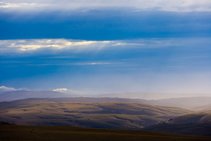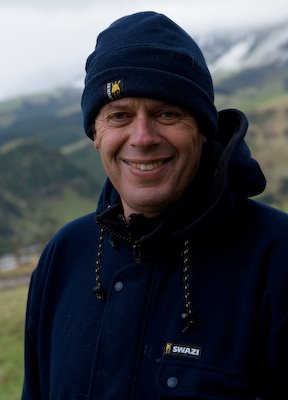
Tawhirimatea kept his promise, and he continues to do so to this day. Sometimes he is content to listen to advice from his parents and forgive his siblings. On those days the weather is fine, clear, and calm.
But sometimes he is reminded of the pain his parents endured when they were separated and the longing they still have for each other. On those days he sends tornadoes, hurricanes, and cyclones to bring havoc to his brothers' lives and to hound their children.
-Maori myth
The purpose of art is washing the dust of daily life off our souls.
Pablo Picasso
How can anybody in their right mind to do this?
Yesterday my son Alex and I drove up onto the Lammermoors. He is 16 and, like young men of that age, will take any opportunity to get behind the wheel. Besides, I was looking forward to teaching him the arcane art of four-wheel driving. I was more than happy with having him at the wheel; he's a good driver and having him do it gave me the opportunity to take a long look at a place about which I have been feeling fairly ambivalent.
There's a reason for this.
When I first arrived in Ranfurly, I was asked if I would mind documenting the Lammermoor range before IT happens. Those of you in New Zealand will know what I'm talking about; those of you offshore will not. What I'm talking about here is a wind farm, and not just any wind farm. I am talking about 1 76 wind turbines, each one 160 m high, littering and desecrating a landscape that is really quite extraordinary in its raw sere beauty.
As I said, my thoughts on the whole concept of wind farms have been ambivalent.
On the one hand, I can accept the need for more power generation, and I will readily concede that wind farms are a relatively eco-friendly way of achieving more power generation. I will concede too that hydroelectric possibilities in this country are increasingly fewer, that all the good sites have been taken and what remains is really only suitable for generating smaller amounts of power. I will concede that wind farms are more eco-friendly than coal-fired power stations (although I would have thought the technology was there to minimise emissions) or nuclear power plants. Wind farms, to my mind, offer a relatively (I use that advisedly) low-impact method of generating more power. I accept that it will bring more money and job opportunities and to the Maniototo-for a time at least.
On the other hand, I cannot help feeling that the quest for more and more generating capacity is a route in quite the wrong direction, that the Lake Hayes project is yet another desecration of a visual heritage we are allowing to slowly slip away. They will spend somewhere in the vicinity of $1.6 billion despoiling one of the most beautiful places in New Zealand, a truly heritage area. They will no doubt have to build extra transmission lines to cope with the electricity being generated. More visual pollution.
I noted with horror that our supposedly “green” government is weighing in on the side of the wind farm, making it plain to the local district Council what the final outcome of all the submissions should be. And why would they not? They are Meridien's chief shareholder; they get a handy slice of the corporate profits. It is to their advantage to encourage greater generating capacity.
It seems to me that there is another way. Instead of building more dams, more wind farms and more high tension lines to carry that generation to houses, surely the intelligent thing would be to encourage self-sufficiency.
Imagine if, instead of spending that amount of money building Propeller City, they were to issue it in the form of nil interest or suspensory loans to enable individual households to install solar heating, and where practicable, small wind turbines. Better still, issue it through local councils so any repayments would be made through rates. That way, when the house sold, payment of the loan would continue. It would be tied to the property rather than the individual. Am I missing something here?
Imagine if they were to subsidise double glazing, effective installation, and passive heating technologies for homes. What if they were to subsidise eco-friendly lightbulbs? They could do it by placing a tax on regular lightbulbs to help subsidise the cost. God knows, they do it for alcohol and tobacco! Better still, why not encourage individual enterprise? Why not make it easier for people to sell excess capacity back to the utilities? Give everybody the opportunity to become a generator in their own right. The power demands of individual households would drop, thereby relieving the load on the generating capacity. Am I missing something here?
As I said, until yesterday, my thoughts and feelings were of two minds.
Yesterday, that changed.
Yesterday we came up onto the Lammermoors, and turned off onto a flat area beside a huge rock outcrop. We got out and looked around, standing in silence for a time, listening to the whispering grasses and the southerly wind plucking fitfully at our hair and clothes. What do you think? I asked Alex. He stood there for a time, absorbed, considering his answer (as he does) and then he replied:
It's beautiful. It’s really beautiful.
As we looked across the vast moor, across the Great Moss Swamp, I told him about the wind farm, about what was proposed. Again there was silence, while he thought about it.
I don't get it, he said. How can they do that to a landscape like this? It’s just awful.
We stayed there, attempting to absorb the vastness before us.
In the late afternoon light the folds and wrinkles of the land were beginning to take on a greater definition. The approaching cold front was playing a counterpoint to the softly-lit landscape. Dark brooding clouds shot with patches of almost leprous white were prowling along the eastern boundary of the Rock and Pillar Range, while the sun played hide and seek behind the front edge of the coming storm.
We photographed on, as the light sculpted the landscape, following the day to its end, working under the deepening frown of the incoming cloud bank until the light sank away and contrast had gone. Then we drove home.
As we came down the escarpment, my feelings crystallised and I knew where I stood on the wind farm proposal.
I have been late coming to the party, and the cynic in me suspects big business and economic imperative will have its way.
But I have to do what I can. For our children's sakes.
How can anybody in their right mind to do this?
Update: Yesterday the government released its draft energy strategy to 2050. We all have until 30 March 2007 to have our say. They say a country gets the government it deserves. They are asking for our feedback. Whichever side of the energy debate we stand, we have the opportunity to have a say. You can access it here.
If you are interested in tidal energy schemes, you might want to check out Crest Energy's resource application to install 200 tidal turbines in the Kaipara Harbour. You can read about it here.






























